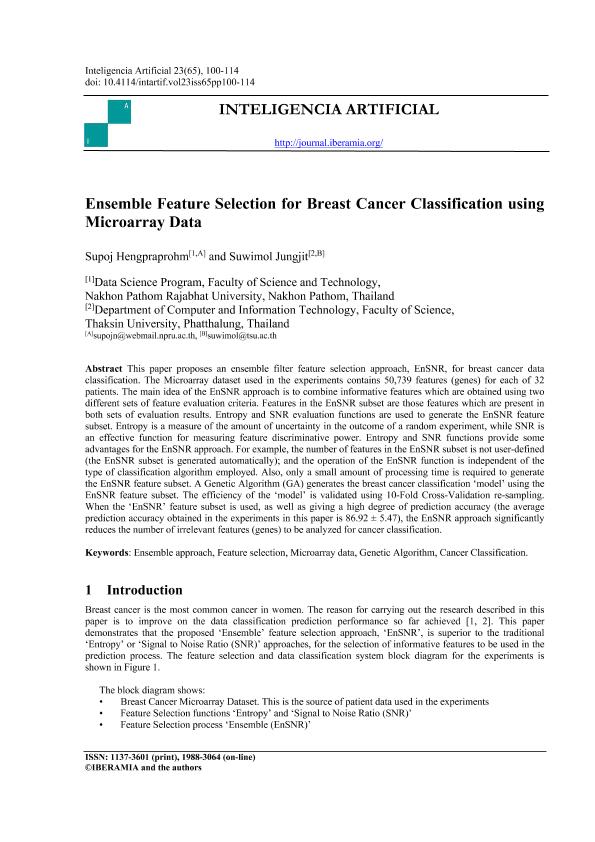| LDR | | | 00000cab a2200000 4500 |
| 001 | | | MAP20200035718 |
| 003 | | | MAP |
| 005 | | | 20220911211109.0 |
| 008 | | | 201110e20200601esp|||p |0|||b|eng d |
| 040 | | | $aMAP$bspa$dMAP |
| 084 | | | $a922.13 |
| 100 | | | $0MAPA20200022053$aHengpraprohm, Supoj |
| 245 | 1 | 0 | $aEnsemble feature selection for breast cancer classification using microarray data$cSupoj Hengpraprohm, Suwimol Jungjit |
| 520 | | | $aThis paper proposes an ensemble filter feature selection approach, EnSNR, for breast cancer data classification. The Microarray dataset used in the experiments contains 50,739 features (genes) for each of 32 patients. The main idea of the EnSNR approach is to combine informative features which are obtained using two different sets of feature evaluation criteria. Features in the EnSNR subset are those features which are present in both sets of evaluation results. Entropy and SNR evaluation functions are used to generate the EnSNR feature subset. Entropy is a measure of the amount of uncertainty in the outcome of a random experiment, while SNR is an effective function for measuring feature discriminative power. Entropy and SNR functions provide some advantages for the EnSNR approach. For example, the number of features in the EnSNR subset is not user-defined (the EnSNR subset is generated automatically); and the operation of the EnSNR function is independent of the type of classification algorithm employed. Also, only a small amount of processing time is required to generate the EnSNR feature subset. A Genetic Algorithm (GA) generates the breast cancer classification model' using the EnSNR feature subset. The efficiency of the model' is validated using 10-Fold Cross-Validation re-sampling. When the EnSNR' feature subset is used, as well as giving a high degree of prediction accuracy (the average prediction accuracy obtained in the experiments in this paper is 86.92 ± 5.47), the EnSNR approach significantly reduces the number of irrelevant features (genes) to be analyzed for cancer classification. |
| 650 | | 4 | $0MAPA20080540500$aCáncer |
| 650 | | 4 | $0MAPA20080562236$aEnfermedades |
| 650 | | 4 | $0MAPA20080578848$aAnálisis de datos |
| 650 | | 4 | $0MAPA20080553128$aAlgoritmos |
| 650 | | 4 | $0MAPA20080576158$aGestión de datos |
| 700 | 1 | | $0MAPA20200022176$aJungjit, Suwimol |
| 773 | 0 | | $wMAP20200034445$tRevista Iberoamericana de Inteligencia Artificial$dIBERAMIA, Sociedad Iberoamericana de Inteligencia Artificial , 2018-$x1988-3064$g01/06/2020 Volumen 23 Número 65 - junio 2020 , p. 100-114 |
| 856 | | | $qapplication/pdf$w1108615$yRecurso electrónico / Electronic resource |


